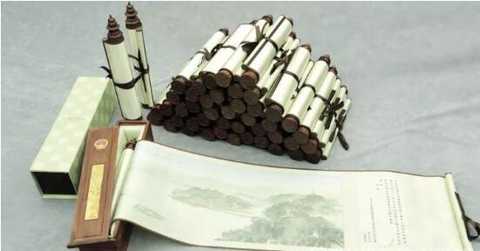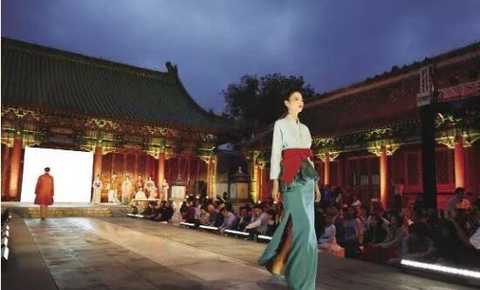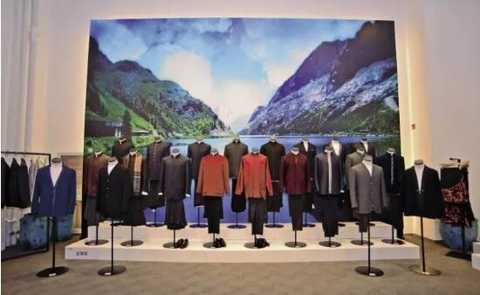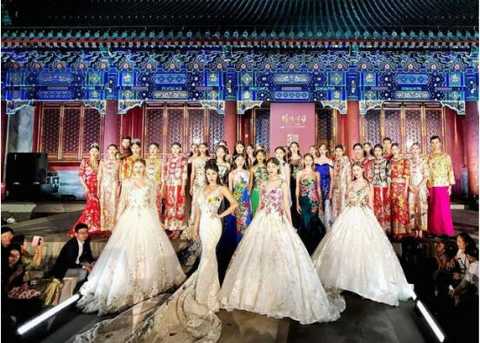From the “New China Costume†dressed by the leaders of the Beijing APEC Summit in 2014, to the “National Gift†blessing bag at the military parade in honor of the 70th anniversary of the victory of the Anti-Japanese War in 2015; the silk supplies that bloomed from the 2016 G20 Hangzhou Summit, to 2017 "Song Jinfu Ship" at the Xiamen Golden Brick Conference... When these textiles carrying heavy culture have appeared in the world again and again, have you been ignited with confidence and pride? These "textiles" that embodies excellent traditional crafts and traditional culture are actually just the tip of the iceberg of the "new image, new positioning, new label" of the Chinese textile industry. Industry is the foundation of a strong country, and culture is the soul of the nation. In the past five years, while the Chinese textile industry has accelerated the development of its scientific and technological strength, it has also focused on the cultural creativity and cultural influence of the textile and garment industry. Inheritance and revitalization are the mission and responsibility of the textile industry. Since the 18th National Congress, from APEC "New China" to the G20 Summit "National Gifts", textiles carrying heavy culture and history have appeared in the world's attention. Always regard the excellent traditional culture from the depth of the deepest spiritual pursuit of the Chinese nation, inherit the excellent traditional culture from the height of the national strategic resources, and innovate and develop the excellent traditional culture from the perspective of promoting the modernization process of the Chinese nation, making it a "two hundred years" "The goal of struggle and the fundamental strength of the Chinese nation's great rejuvenation of the Chinese dream. The National “13th Five-Year Plan†outlines the plan to “deliver the development of excellent traditional culture, strengthen the protection and inheritance of intangible cultural heritage, and revitalize traditional craftsâ€. The traditional craftsmanship is based on the handicrafts handed down from generation to generation by the Chinese nation. It is a historical and cultural carrier that condenses national wisdom. As an important part of traditional culture, traditional crafts carry the most extensive and basic emotions and life of the public. Inheriting local culture, building social harmony, and promoting economic development, traditional crafts show unique value and endless charm. Since the beginning of this year, a number of policies have been introduced to protect the development of China's outstanding traditional culture. In January this year, the General Office of the CPC Central Committee and the General Office of the State Council issued the "Opinions on Implementing the Inheritance and Development of Chinese Excellent Traditional Culture" and issued a notice requesting all localities and departments to conscientiously implement it in accordance with the actual situation; in March this year, the General Office of the State Council Forward the Ministry of Culture, Industry and Information Technology, and the Ministry of Finance's "China Traditional Crafts Revitalization Plan" to deploy and promote the inheritance and revitalization of traditional Chinese crafts. In the "Textile Industry Development Plan (2016-2020)", several requirements for vigorously implementing the "three products" strategy were also proposed: Optimize the product supply structure, pay attention to design innovation, integrate traditional culture and modern fashion, and strengthen the creative design of product forms, product functions, production processes and consumer experience, and develop fashionable and personalized products; Vigorously promote brand building, we must guide enterprises to strengthen brand strategic management, clarify brand positioning, promote the integration of brand and cultural creative industries, high-tech industries, increase the added value and cost performance of brand products; promote traditional culture and modernity such as textile and clothing intangible cultural heritage. Fashion integration and development, enhance the brand culture. Sun Ruizhe, president of the China National Textile and Apparel Council, said that promoting China's excellent traditional culture and revitalizing China's traditional textile technology is of great significance to the construction of a strong textile country. While accelerating the development of scientific and technological hard power, China's textile industry must simultaneously enhance the cultural creativity and cultural influence of the textile and garment industry, regain the sense of self-worth, enhance cultural soft power, enhance cultural consciousness, and rebuild cultural self-confidence. Carry forward the spirit of "big country craftsmen", pursue the fine workmanship, and strive for excellence, providing flexible support for industrial transformation and upgrading. At the same time, "technology, fashion, green" is becoming a "new image, new positioning, new label" for the Chinese textile industry. The textile intangible cultural heritage bearing national DNA is the leading element of “fashion†and is helping the revival of China's splendid traditional culture. Consciousness and self-confidence, adding weight to the "textile non-legacy" In recent years, the popularity of traditional culture, especially “textilesâ€, has been heating up, and cultural awareness and cultural self-confidence have become “popular†in the industry. At the China International Fashion Week, the highest stage in China's fashion industry, more and more designers are keen to use traditional Chinese techniques and traditional techniques. NE·TIGER's silk and brocade, Guangdong Mingrui's dragon and phoenix skirt and nailed gold embroidered, "living in the left" brand of blue printed cloth, "Chu and listening to the fragrance" of the grass dyeing, EVEdeCINA's Buyi clothing pattern... Fashion Designers and fashion brands have explored the beauty of tradition and the rhythm of the East with their hearts, and there have been countless new designs that have touched people's hearts. During the 6-day “Jinxiu China – China Intangible Cultural Heritage Apparel Show†series held in June 2017, Chaozhou embroidery, Su embroidery, Miao embroidery, batik, silk, Song Jin and many other textiles were in the works. The integration of important projects with modern design techniques demonstrates the grand occasion of “revitalization in practice and promotion in lifeâ€, and explains the creative transformation and innovative development of excellent traditional culture. More than clothing, in recent years, China International Home Textiles and Accessories Expo has set up a "China National Textile Intangible Cultural Heritage Exhibition Area", silk, Yunjin, Shujin, Qiang embroidery, blue printed cloth, drawn yarn, Miao batik, Lu embroidery and other textiles. The legacy and the modern home textile industry face each other, and the interaction and interaction have sparked a new spark. At overseas fashion weeks, more and more Chinese fashion designers and Chinese fashion brands are going abroad and going international. Among them, such as Mark's uselessness, Xie Feng's Giffen JEFEN, Wang Chen Caixia's Xia Zi Chen Shiatzy Chen and Ji Wenbo, Zeng Fengfei, Lawrence Xu, etc., all with unique oriental culture, complemented by distinctive The Chinese element has won the attention and recognition of the overseas fashion industry. In 2016, in order to strengthen the textile non-legacy protection and inheritance work, the China Textile Industry Research Center approved the establishment of the Intangible Cultural Heritage Office of the China Textile Economic Research Center in August. China's textile industry has a long history and profound heritage. Traditional techniques such as spinning, dyeing, weaving, embroidering, printing and clothing are deeply rooted in the textile industry. Printing, dyeing, embroidery and national costumes are all over the place. Among the 1,372 national-level intangible cultural heritage projects announced in China, there are more than 100 textiles, which are distributed in three categories: folk art, traditional craftsmanship and folklore. Gao Yong, secretary of the Party Committee and Secretary General of the China National Textile and Apparel Council, pointed out that when it comes to the distinctive characteristics of textiles, it has: profound knowledge and rich variety; second, promoting employment and precision poverty alleviation; third, fine work and individuality; fourth, affinity The people and the integration of life; the fifth is green and strong. Creativity and innovation, full of traditional skills of new life force The vitality of culture lies in innovation. How to “creative transformation and innovative development†of excellent traditional culture is a major practical issue that must be paid attention to at present. The clear direction of the "two creations" policy of "creative transformation and innovative development" is based on practice, and promotes the cultural spirit that transcends time and space, transcends the country, has eternal charm and has contemporary values, and draws on the spirit of inclusiveness. Other outstanding achievements in civilization have revitalized and enriched development and revitalized new vitality. In the Chinese textile and garment industry, a large number of textile entrepreneurs, designers, academic researchers and inheritors of the original and ideal are dedicated to the protection and inheritance of traditional culture and traditional craftsmanship, and obtained in industrial practice. Significant innovations. For example, in order to inherit and innovate traditional skills, Wujiang City Dingsheng Silk Co., Ltd., which insists on making silk, spends 5% of its sales revenue on new product development every year. At the same time, it combines modern loom technology with traditional weaving craftsmanship to realize Song Jin’s Industrialization development. In 2014, the “new middleware†core fabric worn by APEC leaders was the new Song Jin of Wujiang Dingsheng Silk. As a result, Song Jin triggered worldwide attention. How to “creative transformation and innovative development†of excellent traditional culture is a major practical issue that must be paid attention to at present. The famous brand of the wedding EVENING DRESS, the name of the group, has been inherited and innovated in the recent years around the Chinese Wedding Dress culture. As a young entrepreneur, Cai Zhonghan, general manager of Guangdong Mingrui Group, said that it took 60 years to find the initial heart, and the company should use the initial intention of commercial operation to protect the non-legacy. He believes that non-legacy must go to life and find the pain points of young people, not just into the museum. In recent years, the men's wear company Yiwen Group's handicraft workshops have explored, researched and protected folk traditional culture and traditional handicraft techniques in an innovative digital way. According to reports, "Evan·China Handicraft Workshop" has set up a platform for inheriting traditional Chinese handicraft culture by setting up the Embroidery Studio, building a handicraft museum, creating a high-end craft experience journey, and establishing a manual pattern database. The central government called for the realization of precise poverty alleviation, and the Chinese craftsmanship was passed down from generation to generation. Yao Jianping, a national-level non-genetic inheritor of Su embroidery, was invited to be the Suzhou-embroider art consultant of the fashion hit drama "Because of You" last year. How to present Su embroidery in the drama, the display of Su embroidery art and the creation of Su embroidery living space. A lot of work. After the show was broadcast, a lot of young people paid attention to and fell in love with the exquisite Su embroidery. "I want to go to Zhenhu, I want to learn embroidery" has become their mantra. Liu Yuanfeng, dean of the Beijing Institute of Fashion Technology, who participated in and organized the APEC "New China" research and development production, said that the Chinese excellent costume culture is the spiritual symbol of the independence of the Chinese nation. It accumulates the deepest spiritual pursuit of the nation, and it is also the national prosperity and development. Rich in resources. "I hope that through collaborative innovation, we will carry out extensive and in-depth cooperation in national costumes, and continue to expand and strengthen the study of traditional clothing and apparel, in order to protect and innovate traditional costumes, spread modern culture, and inherit long-term civilization." Liu Yuanfeng said. "The innovation of the new era condenses people's cognitive wisdom and practical ability. Its spiritual embodiment and skill level are not a simple material reproduction of the predecessors, but a continuation of the creative spirit. Therefore, it is more important to inherit the tradition. Innovation achieves transcendence.†At the inaugural ceremony of the first China Embroidery Traditional Crafts Revitalization Forum and China Embroidery Art Research Institute held this year, Sun Ruizhe’s “focus on enhancing innovation, marketability, artistry, complementarity, integration and opennessâ€, For the new situation, the revitalization of traditional Chinese textile technology is extremely constructive. He pointed out that it is necessary to actively explore the inheritance and development model in line with the market economic environment, and absorb more powerful, branded, and channel-oriented enterprises to actively participate in the protection and inheritance of intangible cultural heritage, and explore "taking the enterprise as the main body and the market." A new idea and a new model for the inheritance of the upgraded textile traditional craftsmanship, which is oriented, culturally based, and product-based. Knowing the new things, knowing how to come. Carrying forward the fine traditional Chinese culture and revitalizing the traditional Chinese textile technology are of great significance to the construction of a strong textile country. We also have reason to believe that China's textile industry will continue to promote the development of excellent traditional culture with good social and economic benefits. Editor in charge: Xu Yuehua A T-Shirt can be worn all year round, it can bring coolness in summer, and can be used as an inner wear in autumn and winter. SHAOXING LIDONG TRADING CO.,LTD , https://www.lidong-garments.com


